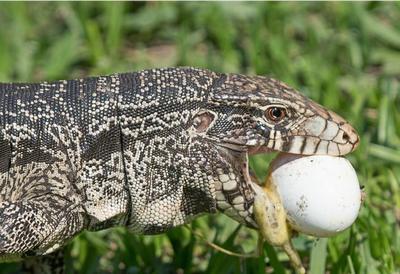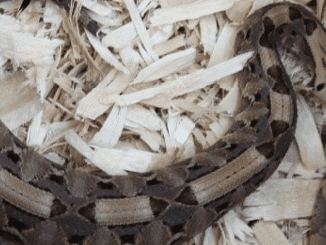
ATLANTA, Georgia, November 24, 2020 (ENS) – Georgia wildlife officials and their partners are scrambling to eradicate a wild population of large invasive black and white Argentine lizards called tegus in two counties in southeast Georgia. Growing from two to four feet long and weighing 10 pounds or more, this lizard native to South America is an invasive species that threatens Georgia wildlife, warns the Georgia Department of Natural Resources (DNR).
For exotic animal lovers, intelligent, docile tegus make good pets. Most tegus in the United States are the product of American breeders, but between 2000 and 2010, more than 79,000 tegus were imported alive from South America, Amy Yackel Adams, a biologist with the U.S. Geological Survey studying the animal, told “National Geographic.” While only a few of the animals escape or are released into the environment, biologists worry that more of the lizards are getting out.

Tegus will eat the eggs of ground-nesting birds, including quail and turkeys, and other reptiles, such as American alligators and gopher tortoises, both protected species. They will also eat chicken eggs, fruit, vegetables, plants, pet food, carrion and small live animals, from grasshoppers to young gopher tortoises.
In Toombs and Tattnall counties, wildlife experts from DNR’s Wildlife Resources Division, the U.S. Geological Survey and Georgia Southern University are trapping tegus, tracking sightings and assessing the population. Early detection, rapid response and public involvement are key to stopping tegus in this area, the experts say.
The Argentine black and white tegu, Salvator merianae, largest of all tegu species, is native to Brazil, Paraguay, Uruguay and Argentina. Black to dark gray with white speckled bands across the back and tail, these reptiles can weigh 10 pounds or more and live 20 years. Hatchlings have bright green on their heads, a coloration that fades at about one month old.
Tegu sizes vary by age. Hatchlings can be up to eight inches long. Adults documented in the wild in Georgia have averaged slightly less than two feet.
It’s been an eventful last couple of weeks for students and faculty in the Biology Department at Georgia Southern University’s Statesboro campus. They’ve been hunting for tegu lizards, which are being found in great numbers in the Toombs and Tattnall County areas. They have trapped the lizards, in an attempt to cut down on their population which can be as many as 30 offspring at a time.
“We’re worried that they’ll become a really invasive species and be detrimental to our native wildlife,” said Georgia Southern biology professor Dr. Lance McBrayer. “And so we’re trying to trap them and get rid of them before they become potentially a big problem.”
When the lizards are trapped, they are euthanized, so research can be done on their bodies. “We’re looking to describe the population, both in terms of how many there might be and then what is the health and reproduction status of these animals,” explained Dr. McBrayer. “So we want to know if they’re breeding, how many of them might be breeding, so that we can get an idea of how big a problem this could potentially become.”
It is difficult to control the breeding of tegus once the reptiles become established in an area.
Tegus have long had a foothold in southern Florida, as pet tegus have either been released by their owners or escaped captivity, but now they’ve made their way to Toombs and Tattnall counties, and in recent months have been seen in several South Carolina counties as well. Biologists say they could be breeding there, too.
Isolated reports of the big black-and-white lizards in Alabama, Louisiana, and Texas, as well as Florida’s central region, have also surfaced.
Tegus are active by day. These fast-moving, terrestrial lizards are rarely found more than a few feet off the ground. But they are strong swimmers and can stay submerged for long periods of time.
Tegus occupy mixed grassland/woodlands and disturbed habitats such as forest clearings, fence rows and roadsides. They winter in burrows or undercover in a hibernation-like state called brumation. In Argentina, tegus are found from sea level up to altitudes of 4,100 feet.
Adult tegus have few predators and can multiply quickly. Females reach reproductive age at about 12 inches long or after their second season of brumation. They can lay about 35 eggs a year. Hatching in Georgia would be expected in June/July.

Although not considered aggressive toward people, tegus will defend themselves if threatened. They can react fast and lash with their tails. They have sharp teeth and claws and strong jaws.
In Georgia, tegus might be confused with native reptiles such as juvenile alligators, which are protected, broadhead skinks and eastern fence lizards, although even as adults, all native lizards would be no larger than a hatchling tegu.
Anyone can help. The Georgia DNR wants people to report to them when they see a tegu in the wild, alive or dead. These reports help biologists document occurrences and respond effectively.
If you think you have spotted an Argentine tegu, take a picture of it, note its location and report the sighting to the Georgia Department of Natural Resources.
Online: www.gainvasives.org/tegus
Phone: (478) 994-1438
Email: gainvasives@dnr.ga.gov
Anywhere wild tegus have been seen, local residents are advised to keep pet food inside, fill holes that might serve as shelter and clear yards of debris such as brush piles that can provide cover for tegus.
Tegus are legal as pets in Georgia but it is illegal to release non-native animals into the wild. The DNR warns, “Be a responsible pet owner. Do your research before buying an exotic pet, and don’t let it loose.”
As a non-native species, tegus in the wild in Georgia are not protected by state wildlife laws or regulations. They can be legally trapped or killed. However, animal cruelty and local ordinances do apply.
Copyright Environment News Service (ENS) 2020. All rights reserved.
© 2020, Environment News Service. All rights reserved. Content may be quoted only with proper attribution and a direct link to the original article. Full reproduction is prohibited.



